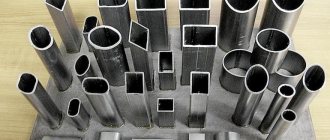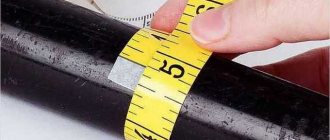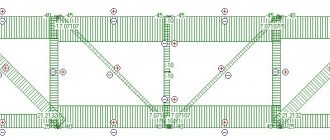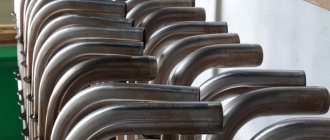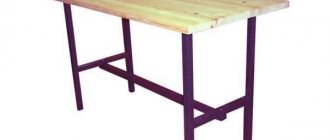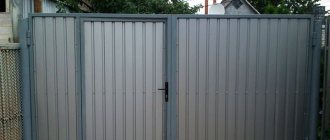Standard sizes and their meaning
The price of profile products exceeds the cost of standard ones, since first craftsmen make standard pipes with round sections, and then convert them into other shapes. The cost is calculated on a per linear meter basis; accordingly, the greater the weight, the higher the price. When developing a project, profile pipes are of particular importance to engineers. Their size and weight directly affect the strength of the building. They are used in furniture frames, residential buildings, and commercial prefabricated buildings, so a mistake can cause a fatal collapse. Most often, frame products are made from steel and aluminum. Due to their higher density, steel pipes are always heavier, but aluminum profile pipes are easier to adjust to the dimensions of the planned structures. To calculate the weight of an individual product, several components are important:
- Width, length and wall thickness;
- Density of different types of steel, aluminum alloys;
- Weight proportional to the dimensions of the product (values are in GOST reference books).
Using the example of a design layout, the engineer calculates the load for each of its fragments and selects appropriately sized profile pipes. It is easiest to make calculations for square and rectangular sections, and for oval sizes it is important to take into account the roundness of the corners. The special GOST marking is a great help.
Geometric data
To calculate the amount of raw material used to produce a pipe, you need to know the following important technical characteristics of the product:
- profile width;
- profile height;
- wall thickness of the profile product.
Accordingly, there is a certain dependence that is unchanged, namely, the greater the value of the above indicators, the more the profile pipe weighs. There is one more parameter that practically does not affect the weight of rectangular and square pipes, but for ovoid (oval) products this characteristic is decisive. This parameter is the bending strength coefficient.
If all the necessary geometric data are known, it is not difficult to calculate the volume that was used to make 1 m of these products. To calculate the weight of a rectangular profile pipe or square part, you will need simple formulas that make it easy to determine this characteristic.
The mass of pipes also depends on their shape, which is also taken into account in the calculations
There are ready-made tables on the Internet, using which you can easily find the ready-made theoretical weight of the required product.
Types of markings
It is difficult for a simple buyer of building materials to calculate the necessary parameters for calculating weight. This requires detailed data, which cannot always be obtained without special equipment:
- Length, width and wall thickness;
- Exact metal composition.
There is information that will make the weight calculation process easier. These are two things - special markings and types of profile pipes. The parameters are indicated inside the product, separated by an “x” icon, according to the following principle:
- Height;
- Width;
- Thickness;
- GOST number (often repeated with a special code).
For example, the designation 20x20x2 and GOST number C-245 indicates that the profile has a square cross-section, both walls are 20 mm, with a thickness of 2 mm, and is made of steel approved by the building code for the construction of durable frames. The length is not always indicated, but usually does not exceed the range of 6-12 m. Sometimes this is indicated at the end of the main marking.
Marking and types of profile pipes
In order to calculate the weight, you need to know several parameters:
- Product dimensions - width and height. In the case of square pipes, the values will be the same.
- Wall thickness. Next, you need to find out what material the pipe is made of. Material parameters can be easily found in special tables.
When a buyer comes to a hardware store, he may have no idea what parameters each pipe has. As a rule, there are no stands with detailed information in the store. But there is a special marking on the pipe itself that allows you to find out all the necessary information about it. It is only important to decipher it correctly.
The marking is as follows: height x width x thickness GOST (number) / material marking GOST material. For example: 15x15x1 GOST 8639-82/ S-245 GOST 27772-88. If we omit the numbers of the corresponding GOSTs, which is only important for specialists in the field of construction and metal structure manufacturing, you can get all the numerical values for calculating weight from the markings:
- The first three numbers allow us to say that the pipe is square, its height and width are 15 mm each, and its thickness is 1 mm.
- The product is made of steel (the first letter in the marking is “C”). Steel marked C-245 is used for building structures. Detailed information about it can be found in the corresponding reference book. If necessary, you can find out about the properties of each product and material according to GOST, where all the important characteristics are given. Sometimes price tags and labeling are simplified. In this case, GOST and information about the material are not written on them, but simply indicate the name, height x weight x wall thickness. For example: profile pipe 15x15x1.
- The length of the profile ranges from 6 m to 12 m. The length is not always indicated, but sometimes it can be found at the end of the marking: 15X15X1 12 m.
We recommend that you read: How to choose a pipe cutter for installing copper pipes
Square profiles
Rolling metal factories prefer to sell products in bulk, without weighing each product individually. The customer’s task is to correctly calculate the mass of the total length of the products. Depending on the type of section, several groups of non-standard rolled metal can be distinguished:
- Oval and square;
- Diamond-shaped and rectangular;
- Square and trapezoidal.
There are special formulas for each option, and you can also use an online calculator and tables, which are often posted directly on the manufacturer’s website. To determine the weight of a square pipe, you need a formula using a constant (0.0157) and the parameters of volume (t), length of the segment (A) and metal density (p):
m = () x 0.0157 x t x (A x 2 – 2.86 x t) x L
The total mass of the batch, in this case, is calculated by multiplying the result obtained by the number of required products.
Determining mass using tables
The range and weight of a linear meter of rectangular and square profile pipes are determined by GOST R 54157-2010. Depending on the production method, the corners of these metal products can be clear or rounded. Roundness has little effect on the mass of a linear meter.
Table of weight per linear meter of square profile pipe, kg
| Section size, mm | Wall thickness, mm | ||||||||||||||
| 0,7 | 0,8 | 1,0 | 1,2 | 1,6 | 1,8 | 2,0 | 2,2 | 2,35 | 2,5 | 2,8 | 3,0 | 3,2 | 3,5 | 4,0 | |
| 10x10 | 0,198 | 0,222 | 0,269 | 0,312 | |||||||||||
| 15x15 | 0,308 | 0,348 | 0,426 | 0,501 | 0,639 | 0,702 | 0,762 | 0,819 | |||||||
| 20x20 | 0,418 | 0,474 | 0,583 | 0,589 | 0,89 | 0,985 | 1,075 | 1,16 | |||||||
| 25x25 | 0,599 | 0,74 | 0,88 | 1,14 | 1,27 | 1,39 | 1,51 | 1,6 | 1,68 | ||||||
| 30x30 | 0,897 | 1,07 | 1,39 | 1,55 | 1,7 | 1,86 | 1,97 | 2,07 | |||||||
| 40x40 | 1,21 | 1,44 | 1,89 | 2,12 | 2,33 | 2,54 | 2,7 | 2,85 | 3,16 | 3,36 | |||||
| 50x50 | 1,82 | 2,4 | 2,68 | 2,96 | 3,24 | 3,44 | 3,64 | 4,04 | 4,31 | 4,56 | 4,95 | 5,56 | |||
| 60x60 | 2,9 | 3,25 | 3,59 | 3,93 | 4,18 | 4,43 | 4,92 | 5,25 | 5,57 | 6,04 | 6,82 | ||||
| 80x80 | 3,9 | 4,38 | 4,84 | 5,31 | 5,66 | 6,0 | 6,68 | 7,13 | 7,58 | 8,24 | 9,33 | ||||
| 100x100 | 6,1 | 6,69 | 7,13 | 7,57 | 8,44 | 9,13 | 9,59 | 10,44 | 12,05 | ||||||
Oval sections
Profiles with an oval cross-section are produced by flattening round blanks. Stainless chrome-plated steel is optimal for them. They are used in decorative and frame structures, cooling systems, since the oval shape allows heat to be transferred faster than the round counterpart, while the surface area is larger. The equations used to calculate the masses of square and rectangular profiles are not suitable for calculating the weight of a linear meter of a profile pipe with an oval cross-section, since they do not take into account the diameter and rounded corners. The most reliable way is to use a calculator or lookup tables, but if this is not possible, but you need to find out the weight, then you can do this using a universal formula, suitable not only for oval, but also for profiles of more complex shapes:
m = (metal density) x S (diameter) x L (segment length).
Rectangular pipes
Instead of light aluminum ones, steel pipes with a rectangular cross-section are used as spacers in frames of any type and floors of houses. The formula used to calculate the mass of square profiles is not suitable for rectangular ones, since the sides of the section are not equal in length. There are two options - use a sample calculation yourself or fill out a special section of the calculator. The general equation for rectangular profiles is:
m = ((material density) / 7850) x 0.0157 x t (wall thickness) x (A (1 side of the rectangle) + B (2 side of the section) – 2.86 x t) x L (length of the segment).
It is preferable to use a calculator, since it can also calculate the deflection and bending of the profile and determine the total mass according to 5-6 schemes (with uniform and concentrated power load) and according to two GOST options. The maximum amount of deflection and bending can be entered independently, as well as other clarifying details. The calculation result in this case will be more accurate than using a general equation.
Classification of profile pipes
The classification of pipes is as follows:
- by material of manufacture: aluminum, steel;
- cross-sectional shape: square, rectangular, oval;
- length: 6 m and 12 m;
- in width and height: values from 10 mm to 180 mm;
- by wall thickness: values from 1 mm to 12 mm.
This is interesting! The standard length is not always suitable for creating one type of structure or another. For an additional fee, you can ask the supplier to cut six-meter pipes to three meters. If longer versions are needed, you will have to cook them yourself.
Permissible errors and deviations
Any calculation method - using a formula, tables or calculator - gives a small percentage of error. The use of a constant indicator of the density of materials in calculations is conditional, since different alloys and types of steel are not the same in weight. The final indicator differs from the actual one, but when using a calculator this deviation is minimal, because the program is designed to enter the maximum possible number of parameters. To completely eliminate errors and omissions, it is necessary to check the parameters of the parts with the tables of GOST 30245-2003, where the standards and permissible errors are recorded:
- The length of the product and the cross-sectional area of the profile must coincide with the digital indicators in the tables, although a cross-sectional error of 1.5 - 2 degrees and 2 mm in length is allowed;
- The maximum deviation of a pipe 15 cm wide is 1 mm per linear meter;
- Deviation from a right angle of more than 1.5 mm is unacceptable;
- The classic length of 6-12 meters can be changed at the request of customers into segments of 3-4 meters;
- The wall thickness of the batch must match that of the control sample 15 cm long.
If the specified data and numerical indicators in the tables are exceeded, the strength of building structures may be at risk.
Profile pipe weight: tables and pipe calculator
Construction science is a complex relationship between physics and mathematics; it cannot be done without certain knowledge and the ability to calculate various values.
For example, to properly organize transportation, it is important to know in advance the weight of the profile pipe, and not just its dimensions and dimensions, otherwise you may simply choose a vehicle for transportation or not fit all the pipes into one vehicle. Let's figure out how to calculate the specific gravity of a certain type of pipe, what types of pipes there are, and the best way to transport them.
Types and sizes of pipes
Profile pipes are very popular today and are used in various construction activities, from laying paving slabs to welding work. In this regard, there are several types of metal profile pipes on the market:
- Rectangular;
- Square;
- Oval;
- Flat oval;
- Hexagonal;
- Triangular.
The most popular types of profiles are rectangular, square and oval pipes.
There is also a wide range of standard sizes of profile pipes. Standard professional pipes have a diameter from 15 to 300 millimeters, a wall thickness from 1 to 12 millimeters, but the weight is determined using a special mold - it directly depends on the shape of the pipe and what dimensions it has.
Marking, symbols and GOST
Depending on the size and type, steel pipes have different markings, which are prescribed in the state standards of the Russian Federation:
- GOST 8639 82 – square steel profile pipe;
- GOST 8645 82 – rectangular;
- GOST 10704 91 – straight-seam electric welded;
- GOST 8642 68 – oval.
These are the main 4 types that are most popular in the construction industry.
Tables of weight of steel pipes of various GOST and TU 1 meter
In order to calculate the specific gravity of a profile, a special table of the weight of a profile pipe is used, with which you can calculate the mass of a certain type of pipe by multiplying the length by the weight of a linear meter.
The characteristics of the best manufacturers and the standard sizes of their products are given in the tables below.
GOST 8639 82 – Square steel pipes
| Section square parameters | Weight of 1 linear meter |
| 15×15x1.0 | 0,479 |
| 15×15x1.2 | 0,501 |
| 15×15x1.5 | 0,605 |
| 20×20x1.2 | 0,689 |
| 20×20x1.5 | 0,841 |
| 20×20x2 | 1,08 |
| 25×25x1.2 | 0,877 |
| 25×25x1.5 | 1,07 |
| 25×25x2 | 1,39 |
| 30×30x1.5 | 1,31 |
| 30×30x2 | 1,70 |
| 40×40x1.5 | 1,78 |
| 40×40x2 | 2,33 |
| 40×40x2.5 | 2,85 |
| 40×40x3 | 3,36 |
| 40×40x4 | 4,30 |
| 50×50x2.5 | 3,64 |
| 50×50x3 | 4,31 |
| 50×50x3.5 | 4,94 |
| 50×50x4 | 5,56 |
| 60×60x2 | 3,59 |
| 60×60x2.5 | 4,43 |
| 60×60x3 | 5,25 |
| 60×60x3.5 | 6,04 |
| 60×60x4 | 6,82 |
| 80×80x3 | 7,13 |
| 80×80x4 | 9,33 |
| 80×80x5 | 11,44 |
| 80×80x6 | 13,46 |
| 100×100x3 | 9,02 |
| 100×100x4 | 11,84 |
| 100×100x5 | 14,58 |
| 100×100x6 | 17,22 |
| 100×100x7 | 17,3 |
| 100×100x8 | 22,25 |
| 120×120x4 | 14,35 |
| 120×120x5 | 17,72 |
| 120×120x6 | 20,99 |
| 120×120x8 | 27,27 |
| 140×140x5 | 20,86 |
| 140×140x6 | 24,76 |
| 150×150x5 | 22,43 |
| 150×150x6 | 26,64 |
| 150×150x8 | 34,81 |
| 160×160x4 | 19,38 |
| 160×160x5 | 24,00 |
| 160×160x6 | 28,53 |
| 160×160x8 | 37,32 |
| 180×180x5 | 27,14 |
| 180×180x6 | 32,30 |
| 180×180x8 | 42,34 |
| 180×180x10 | 52,03 |
| 200×200x6 | 36,06 |
| 200×200x8 | 47,37 |
| 200×200x10 | 58,31 |
| 200×200x12 | 68,89 |
| 250×250x6 | 45,48 |
| 250×250x8 | 59,93 |
| 250×250x10 | 74,01 |
| 250×250x12 | 87,73 |
| 300×300x6 | 54,90 |
| 300×300x8 | 72,49 |
| 300×300x10 | 89,71 |
| 300×300x12 | 106,6 |
GOST 8645 82 – Rectangular steel pipes
| Options | Weight of 1 linear meter |
| 20x10x1.2 | 0,501 |
| 20x10x1.5 | 0,605 |
| 25x10x1.5 | 0,723 |
| 28x25x1.2 | 0,934 |
| 28x25x1.5 | 1,15 |
| 28x25x2 | 1,48 |
| 30x15x1.5 | 0,959 |
| 30x20x1.5 | 1,08 |
| 30x20x2 | 1,39 |
| 40x20x1.5 | 1,31 |
| 40x20x2 | 1,70 |
| 40x25x1.5 | 1,43 |
| 40x25x2 | 1,86 |
| 40x25x2.5 | 2,27 |
| 50x25x1.5 | 1,67 |
| 50x20x2 | 2,02 |
| 50x25x2 | 2,17 |
| 50x30x2 | 2,32 |
| 50x30x2.5 | 2,86 |
| 50x40x2.0 | 2,65 |
| 50x40x2.5 | 3,25 |
| 50x40x3.5 | 4,39 |
| 60x30x2 | 2,65 |
| 60x30x2.5 | 3,25 |
| 60x30x3 | 3,83 |
| 60x40x2 | 2,96 |
| 60x40x3 | 4,30 |
| 60x40x3.5 | 4,94 |
| 60x40x4 | 5,56 |
| 80x40x2 | 3,59 |
| 80x40x2.5 | 4,43 |
| 80x40x3 | 5,25 |
| 80x40x4 | 6,82 |
| 80x60x3 | 6,19 |
| 80x60x4 | 8,07 |
| 100x50x3 | 6,66 |
| 100x50x4 | 8,70 |
| 100x50x5 | 10,65 |
| 100x60x3 | 7,13 |
| 100x60x4 | 9,33 |
| 100x60x5 | 11,44 |
| 100x80x4 | 10,59 |
| 100x80x5 | 13,01 |
| 120x60x3 | 8,07 |
| 120x60x4 | 10,59 |
| 120x60x5 | 13,00 |
| 120x80x4 | 11,84 |
| 120x80x5 | 13,01 |
| 120x80x6 | 17,22 |
| 140x60x4 | 11,84 |
| 140x60x5 | 14,58 |
| 140x100x4 | 14,35 |
| 140x100x5 | 17,72 |
| 140x100x6 | 20,99 |
| 150x100x5 | 18,50 |
| 150x100x6 | 21,93 |
| 150x100x8 | 28,53 |
| 160x80x5 | 17,72 |
| 160x120x5 | 20,86 |
| 160x120x6 | 24,76 |
| 180x100x6 | 24,76 |
| 180x100x8 | 32,29 |
| 200x120x5 | 24,00 |
| 200x120x6 | 28,53 |
| 200x160x5 | 27,14 |
| 200x160x6 | 32,30 |
| 230x160x8 | 46,11 |
Of course, for convenience, when purchasing a pipe, it can be cut into several parts, so take into account that the length can be from 3 to 12 meters, depending on the client’s wishes. There are also special sizes that differ from the standard ones; if necessary, they can be ordered on an individual basis. And now you can figure out how the weight of a linear meter of a profile pipe is calculated.
Pipe weight calculator
The formula for calculating the specific gravity of a profile is quite difficult to master; it takes into account the following indicators:
- Material density;
- The width and height of the profile section or its diameter;
- Wall thickness;
- Pipe length;
If you use stainless steel pipes, you can use the tables above for calculations, simply multiplying the pipe length in meters by the specific gravity of 1 linear meter, which is indicated in the table opposite the profile size.
If you decide to purchase a galvanized profile, aluminum profile or copper profile pipes, you can calculate the specific gravity using a special calculator.
In it you can select materials, for example stainless steel, enter dimensions and calculate the weight of the pipe, whether it is thick-walled or thin-walled, you can also read the values from the reference book.
Here you can calculate the density of the material.
Rolled metal calculator © metcalc.ru
Unfortunately, this calculator cannot calculate how much plastic pipes weigh; it can only indicate various metal materials and calculate their theoretical weight.
Limit deviations and tolerances
The maximum possible deviations in height and width may be as follows:
- With a profile height of up to 10 centimeters +/-1;
- If the profile height is more than 10 centimeters +/-0.8.
The cross section of the profile product may deviate from the right angle by no more than 1 degree.
What is the best way to transport corrugated pipe from the metal depot to your site?
Having found out the weight and size of a square pipe, you will have to think about how to transport a profile of this size. Of course, everything depends on the total number and dimensions of pipes.
Different modes of transport can accommodate different profiles. Let's figure out how you can transport pipes of one size or another.
8-12 meters
To transport profile pipes of this size, you will need a long vehicle with a total side length of 13.5 m. This range is the heaviest and at the same time the most capacious cargo carrier. The entry of such transport into many cities is prohibited, so the transportation route should be thought out in advance, and if possible, hire another transport and purchase a profile of shorter length.
6 meters (the most common option)
Most often, metal warehouses offer profile pipes 6 meters long; they are easier to transport, they have less weight, and most importantly, they meet the needs of most clients. If you need to transport 1-4 such profiles, then you can use an ordinary gazelle as a carrier - expensive and angry, not every driver will agree to such an undertaking, because the installation of the cargo will be “with a twist.”
If there are more than 4 profile pipes, then it is better to hire a Kamaz or a truck - they will deliver the cargo safely and securely, and most importantly, there will be no problems on the way to the site.
3 meters
A three-meter profile can be taken away in almost any car, but according to the Administrative Code, it is best, of course, to carry out this procedure using a gazelle. You can fit several dozen products of this length in it.
In any case, it is better not to take risks and hire a car with a body longer than the dimensions of the profile products that you decide to transport, this way you will protect the driver from fines, and yourself from unnecessary hassle when delivering building materials.
(3
Source: https://vseotrube.ru/materialy/metallicheskie/ves-profilnoj-truby
Pipe weight calculator
When ordering a large batch of products, the easiest and fastest way is to use a pipe weight calculator. By calculating the weight of 1 meter of rolled metal on it, you can find out as accurately as possible the total mass of the entire batch, regardless of the complexity of the section - a simple square or a complex polygon. First you need to find out detailed information about the features of the profiles, including alloy composition and possible deviations from GOST, and enter them into the grid cells. A standard calculation will require knowledge of the following nuances:
- Conditional, nominal and outer diameter;
- Width, height and thickness of the product;
- Maximum permissible deflections and loads;
- Span length;
- Distance between supports and load application points;
- Size and number of pipes;
- Brand and main composition of the metal.
Correct and detailed filling of the cells guarantees the accuracy of the result, regardless of the dimensions of the product, which is a guarantee of the safety of the building as a whole.
Determining the weight of the pipe
At this stage some difficulties may arise. There are several calculation methods:
- according to a special formula,
- by calculator,
- according to the table.
Formula
For convenience, there is a simplified formula that allows you to find out the approximate weight of the pipe.
It looks like this: weight = wall thickness x 2 x (height + width) x material density. All lengths are indicated in centimeters.
In the example given, the following values are obtained: 0.1 x 2 x (0.15 + 0.15) x 7850 = 471 g. Please note that this is the weight in grams.
This formula allows you to calculate the weight of 1 meter. Therefore, one such pipe 12 m long will weigh (12 x 471 = 5652) approximately 5.7 kg.
Calculator
You can greatly simplify the task of calculating the weight of the pipe. There are online calculators on the Internet, where all values are calculated automatically; you just need to enter the initial data. To calculate using the calculator, you need to enter the values of wall thickness, length, height and density of the material. Some sites ask for material instead of density.
Tables
The last, simplest option is to refer to a special table. This method is intended for the lazy, but it is more accurate than calculating using a simplified formula.
When using the table, two rules must be followed:
- The first thing is to pay attention to what shape and what material this table is intended for. As a rule, its name indicates GOST, by which these parameters can be determined.
- Secondly, it is worth considering that all the values in the table are not absolutely accurate; in fact, there may be some deviations from the obtained result.
We recommend that you read: Rolled sheet metal
For example, according to the table, the weight of a 15x15x1 structural steel pipe is 479 g. This value differs by 8 g from the previously calculated one, which can be considered a minor error. For the whole it is 96 g.
